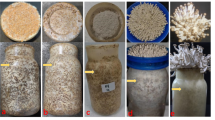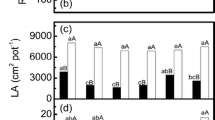Abstract
Cherry is an important fruit tree with delicious taste and high economic value, which have been planted worldwide. However, this species cannot withstand the presence of excessive amount of water; submergence injury sometimes occurs during cultivation of cherry and results in severe economic losses. By using a submergence-tolerant germplasm Prunus serrulata “Yimeng” and a submergence-sensitive germplasm Prunus pseudocerasus “Aihua” as test materials, this study cloned PsERF and PsCIPK, which are related to submergence tolerance in cherry, and analyzed the expression of PsERF and PsCIPK in submergence-tolerant and submergence-sensitive germplasms under submergence stress; moreover, the consistency and correlation of such expression with carbohydrate metabolism and plant growth-related genes (PsPDC, PsSUS, PsRAMY, and PsEXP) were analyzed. The results showed that PsERF and PsCIPK influence the expression of PsPDC, PsSUS, PsRAMY, and PsEXP at different extents under submergence and during recovery to systematically improve the submergence resistance of P. serrulata “Yimeng”. This study lays the important theoretical and practical foundation for molecular improvement and germplasm innovation in submergence tolerance in cherry through genetic engineering.







Similar content being viewed by others
Abbreviations
- AP2/ERF:
-
APETALA2/Ethylene responsive factor
- SUB1:
-
Submergence 1
- HRE:
-
Hypoxia responsive ERF
- CIPK:
-
Calcineurin B-like–interacting protein kinase
- RAMY:
-
α-Amylase
- SUS:
-
Sucrose Synthase
- ADH:
-
Alcohol dehydrogenase
- PDC:
-
Pyruvate decarboxylase
- EXP:
-
Expansin
- GA:
-
Gibberellin
- ABA:
-
Abscisic acid
References
Kumutha, D., Sairam, R. K., Ezhilmathi, K., Chinnusamy, V., & Meena, R. C. (2008). Effect of waterlogging on carbohydrate metabolism in pigeon pea (Cajanus cajan L.): Upregulation of sucrose synthase and alcohol dehydrogenase. Plant Science, 175, 706–716.
Liao, H. B., Meng, X. L., & Guo, W. D. (2011). Effects of different rootstocks on the flood resistance of sweet cherries. J. Anhui Agri. Sci., 39(22), 13335–13339.
Zhang, Z. X., Zou, X. L., Tang, W. H., & Zheng, Y. L. (2006). Revelation on early response and molecular mechanism of submergence tolerance in maize roots by microarray and suppression subtractive hybridization. Environmental and experimental botany, 58(1–3), 53–63.
Pedersen, O., Malik, A. I., & Colmer, T. D. (2010). Submergence tolerance in Hordeum marinum: dissolved CO2 determines underwater photosynthesis and growth. Funct. Plant Bio., 37(6), 524–531.
Pena-Castro, J. M., van Zanten, M., Lee, S. C., Patel, M. R., Voesenek, L. A. J. C., Fukao, T., & Bailey-Serres, J. (2011). Expression of rice SUB1A and SUB1C transcription factors in Arabidopsis uncovers flowering inhibition as a submergence tolerance mechanism. The plant journal, 67(3), 434–446.
Xu, K., Xu, X., Fukao, T., Canlas, P., Maghirang-Rodriguez, R., Heuer, S., Ismail, A. M., Bailey-Serres, J., Ronald, P. C., & Mackill, D. J. (2006). Sub1A is an ethylene-response-factor-like gene that confers submergence tolerance to rice. Nature, 442(7103), 705–708.
Lee, K. W., Chen, P. W., Lu, C. A., Chen, S., Ho, T. H., & Yu, S. M. (2009). Coordinated responses to oxygen and sugar defficiency allow rice seedlings to tolerate flooding. Science Signaling, 2(91), ra61.
Yang, C. Y., Hsu, F. C., Li, J. P., Wang, N. N., & Shih, M. C. (2011). The AP2/ERF transcription factor AtERF73/HRE1 modulates ethylene responses during hypoxia in Arabidopsis. Plant physiology, 156, 202–212.
Hess, N., Klode, M., Anders, M., & Sauter, M. (2011). The hypoxia responsive transcription factor genes ERF71/HRE2 and ERF73/HRE1 of Arabidopsis are differentially regulated by ethylene. Physiologia Plantarum, 143(1), 41–49.
Insausti, P., Grimoldi, A. A., Chaneton, E. J., & Vasellati, V. (2001). Flooding induces a suite of adaptive plastic responses in the grass Paspalum dilatatum. New Phytol., 152, 291–299.
Aschi-Smiti, S., Chaïbi, W., Brouquisse, R., Ricard, B., & Saglio, P. (2003). Assessment of enzyme induction and aerenchyma formation as mechanisms for flooding tolerance in Trifolium subterraneum ‘park’. Annals of botany, 91, 195–204.
Ashraf, M., & Habib-ur-Rehman. (1999). Interactive effects of nitrate and long-term waterlogging on growth, water relations and gaseous exchange properties of maize (Zea mays L.) Plant science, 144(1), 35–43.
Shiono, K., Takahashi, H., Colmer, T. D., & Nakazono, M. (2008). Role of ethylene in acclimations to promote oxygen transport in roots of plants in waterlogged soils. Plant Science, 175, 52–58.
Santosa, I. E., Ram, P. C., Boamfa, E. I., Laarhoven, L. J. J., Reuss, J., Jackson, M. B., & Harren, F. J. M. (2007). Patterns of peroxidative ethane emission from submerged rice seedlings indicate that damage from reactive oxygen species takes place during submergence and is not necessarily a post-anoxic phenomenon. Planta, 226(1), 193–202.
Perata, P., & Voesenek, L. A. C. J. (2007). Submergence tolerance in rice requires Sub1A, an ethylene-response-factor-like gene. Trends in Plant Sci., 12(2), 43–46.
Jackson, M. B., & Ram, P. C. (2003). Physiological and molecular basis of susceptibility and tolerance of rice plants to complete submergence. Annals of Botany, 91, 227–241.
Lee, D. K., Ahn, J. H., Song, S. K., Choi, Y. D., & Lee, J. S. (2003). Expression of an expansin gene is correlated with root elongation in soybean. Plant physiology, 131(3), 985–997.
Umeda, M., & Uchimiya, H. (1994). Differential transcript levels of genes associated with glycolysis and alcohol fermentation in rice plants (Oryza sativa L.) under submergence stress. Plant physiology, 106, 1015–1022.
Sachs, M. M., Subbiah, C. C., & Saab, I. N. (1996). Anaerobic gene expression and flooding tolerance in maize. Journal of experimental botany, 47, 1–15.
Chen, Q., Guo, X. W., Hu, Y. L., Li, J., Gao, X. B., Wang, C., Hao, Y. H., Zhao, L., & Mao, Z. Q. (2007). Effects of water-logging on anaerobic respiration enzymes and fermentation products in roots of two kind of sweet cherry rootstocks. Acta ecologica sinica, 27(11), 4925–4931.
Sheng, L. X., Feng, L. G., & Shu, H. R. (2008). Effect of calcium on the functions of antioxidant systems and mitochondria in cherry rootstock roots under hypoxia stress. Sci. Agr. Sin., 41(11), 3913–3919.
Hao, Y. H., Hu, Y. L., Shen, X., Mao, Z. Q., Wang, Y. Z., Su, L. T., & Yang, S. Q. (2009). Exogenous NO3 − enhanced sugar contents and sucrose correlated enzymes activity in roots of sweet cherry under waterlogging condition. Acta Hortic. Sinica., 36(7), 937–944.
Meng, X. Y. (2016). Cloning and expression analysis of genes related to waterlogging tolerance in cherry. Master Thesis. Yangzhou: Yangzhou University.
Feng, L. G., Chen, C., Li, T. L., Wang, M., Tao, J., Zhao, D. Q., & Sheng, L. X. (2014). Flowery odor formation revealed by differential expression of monoterpene biosynthetic genes and monoterpene accumulation in rose (Rosa rugosa Thunb.) Plant Physiol. Bioch., 75, 80–88.
Schmittgen, T. D., & Livak, K. J. (2008). Analyzing real-time PCR data by the comparative CT method. Nature protocols, 36, 1101–1108.
Kudahettige, N. P., Pucciariello, C., Parlanti, S., Alpi, A., & Perata, P. (2011). Regulatory interplay of the Sub1A and CIPK15 pathways in the regulation of α-amylase production in flooded rice plants. Plant biology, 13, 611–619.
Sheng, L. X., Feng, L. G., & Shu, H. R. (2009). Effects of nitrogen on the activity of antioxidant enzymes and functions of mitochondria in cherry rootstock toots under hypoxia stress. Acta Hortic. Sinica., 36(11), 1575–1580.
Sheng, L. X., Feng, L. G., & Shu, H. R. (2011). Effects of applying calcium on the functions and nitrogen metabolism of cherry root system under hypoxia stress. Chinese J. Ecol., 30(10), 2209–2213.
Feng, L. G., Sheng, L. X., & Shu, H. R. (2010). Effects of exogenous NO3 − on cherry root function and enzyme activities related to nitrogen metabolism under hypoxia stress. Chinese J. Appl. Ecol., 21(12), 3282–3286.
Vriezen, W. H., Graaf, B. D., Mariani, C., & Voesenek, L. A. C. J. (2000). Submergence induces expansin gene expression in flooding-tolerant Rumex palustris and not in flooding-intolerant R. acetosa. Planta, 210(6), 956–963.
Fukao, T., Xu, K., Ronald, P. C., & Bailey-Serres, J. (2006). A variable cluster of ethylene response factor-like genes regulates metabolic and developmental acclimation responses to submergence in rice. The Plant Cell, 18(8), 2021–2034.
Jung, K. H., Seo, Y. S., Walia, H., Cao, P. J., Fukao, T., Canlas, P. E., Amonpant, F., Bailey-Serresand, J., & Ronald, P. C. (2010). The submergence tolerance regulator Sub1A mediates stress-responsive expression of AP2/ERF transcription factors. Plant Physiology, 152(3), 1674–1692.
Morimoto, K., & Yamasue, Y. (2007). Differential ability of alcohol fermentation between the seeds of flooding-tolerant and flooding-susceptible varieties of Echinochloa crusgalli (L.) Beauv. Weed Biol. Manag., 7(1), 62–69.
Dennis, E. S. (2000). Molecular strategies for improving waterlogging tolerance in plants. Journal of experimental botany, 51, 89–97.
Geigenberger, P. (2003). Response of plant metabolism to too little oxygen. Current opinion in plant biology, 6, 247–256.
Ruan, Y. L., & Chourey, P. S. (1998). A fiberless seed mutation in cotton is associated with lack of fiber cell initiation in ovule epidermis and alterations in sucrose synthase expression and carbon partitioning in developing seeds. Plant Physiology, 118(2), 399–406.
Huang, S. B., Colmer, T. D., & Millar, A. H. (2008). Does anoxia tolerance involve altering the energy currency towards Ppi? Trends in Plant Science, 13, 221–227.
Crawford, R. M. M., & Brndle, R. (1996). Oxygen deprivation stress in a changing environment. Journal of experimental botany, 47, 145–159.
Li, J. (2008). Effects of different nitrogen types on the physiological and biochemical characteristics during recovery of waterlogging in sweet cherry. Doctoral dissertation. Tai’an: Shandong Agricultural University.
Eck, W. H. J. M. V., Steeg, H. M. V. D., Blom, C. W. P. M., & Kroon, H. D. (2004). Is tolerance to summer flooding correlated with distribution patterns in river floodplains? A comparative study of 20 terrestrial grassland species. Oikos, 107, 393–405.
Acknowledgments
This research was funded by National Natural Science Foundation of China (Grant No. 31301746).
Author information
Authors and Affiliations
Contributions
L.X. Sheng and L.G. Feng conceived and designed the experiments. X.Y. Meng and M. Wang performed the experiments. L.X. Sheng and X.Y. Meng analyzed the data and wrote the paper. S. Zang contributed reagents/materials/analysis tools.
Corresponding author
Ethics declarations
Conflict of Interest
The authors declare that they have no conflict of interest.
Rights and permissions
About this article
Cite this article
Sheng, L., Meng, X., Wang, M. et al. Improvement in Submergence Tolerance of Cherry Through Regulation of Carbohydrate Metabolism and Plant Growth by PsERF and PsCIPK . Appl Biochem Biotechnol 184, 63–79 (2018). https://doi.org/10.1007/s12010-017-2530-4
Received:
Accepted:
Published:
Issue Date:
DOI: https://doi.org/10.1007/s12010-017-2530-4




